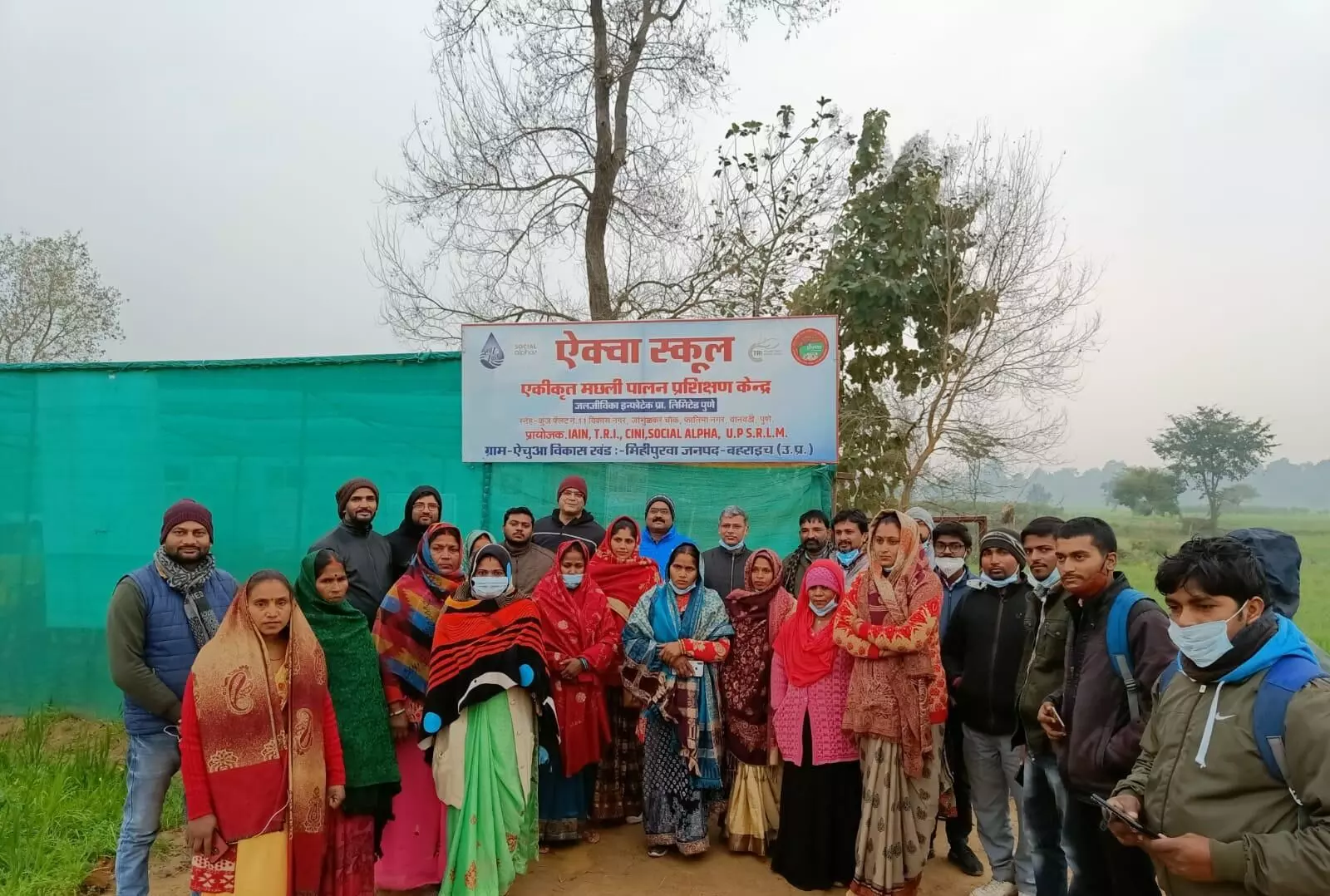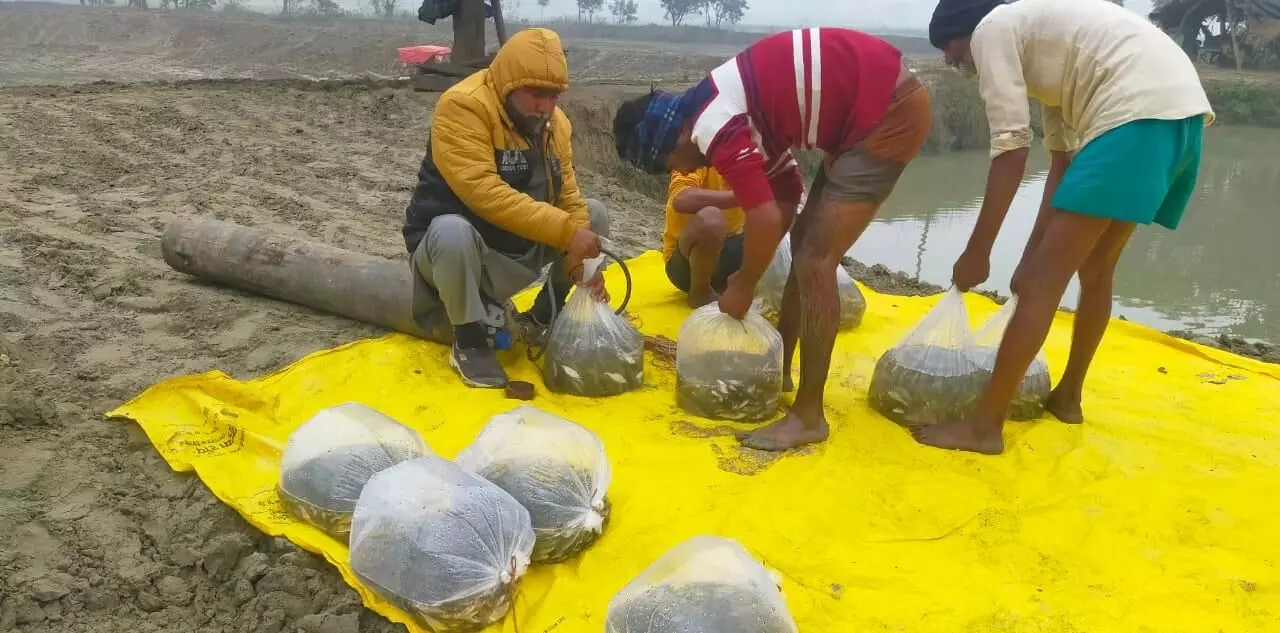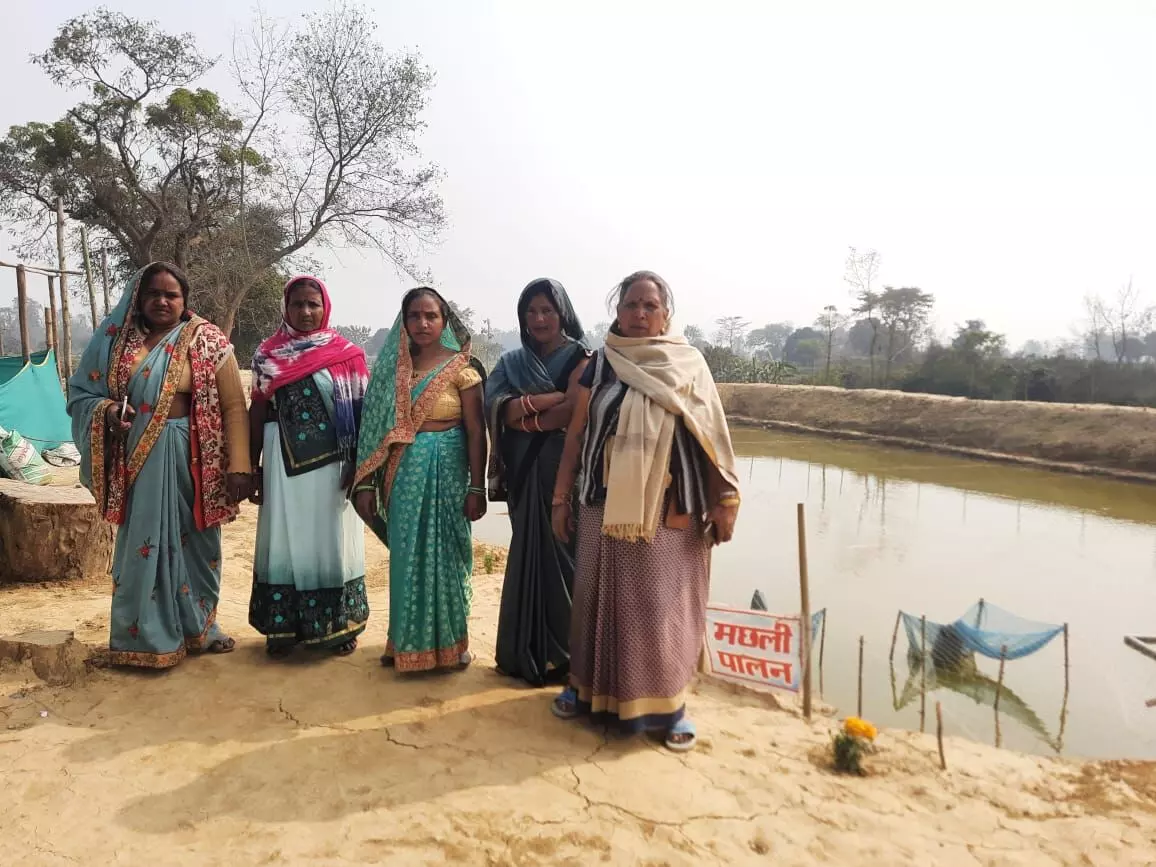Bahraich, Uttar Pradesh
Sunita Devi who has traditionally cultivated mustard and wheat for years on her acre and a half of land, has decided to stop as the crops have earned her no significant profits. The 42-year old farmer from Ainchuwa village in Bahraich district is now all set to venture into pisciculture and poultry farming.
“Dedh acre ka jameen hai. Ek bigha me machhli palan fasa lengey [I have 1.5 acre land; I will use one bigha land for fish farming],” she told Gaon Connection excitedly while she was attending a training on fish farming in her village located about 175 kilometres from the state capital Lucknow. Close to 40 farmers had gathered for the session.
“Where can we get quality fingerlings? What should be the temperature of water in a fish pond,” Sunita asked the trainer from Transform Rural India Foundation (TRIF), a grassroots organisation, which, in collaboration with non-profit Jal Jeevika, is working with the small-scale fishers and pond owners in Bahraich to enhance fish production and productivity in the district. An Aqua school for farmers was also set up in Ainchuwa village last December.
Watch video:
Like Sunita, 196 farmers in Mihinpurwa block of Bahraich district are hoping for an alternative livelihood in fish farming. They are fed up with the repeated losses they suffer due to floods and the growing stray cattle problem in the state.
“We want to train as many farmers in fish farming and increase their income. In an acre of pond, farmers can earn up to five lakh rupees in a year with an investment of only one lakh,” Murari Jha, project manager, TRIF, Bahraich, told Gaon Connection.
“The demand for fish is high here. As of now, merchants buy fish from neighbouring districts like Lakhimpur Kheri and Pilibhit to sell here. Only ten per cent of the demand is being met right now from the Mihinpurwa block. We want to escalate that so that local farmers reap benefits,” the project manager said. “We aim to connect with fifteen thousand farmers in three years so that we can help boost their income,” he added.

An Aqua school for farmers was also set up in Ainchuwa village last December. Photo: By arrangement
Uttar Pradesh is coming up as a major fisheries hub. According to data provided by the Department of Fisheries, the eastern districts of the state have recorded a whopping 47 per cent of the total production of inland fishes in 2020-21. The other regions that shared the production are central (21 per cent), western (18 per cent) and southern region of Bundelkhand that contributed 14 per cent of the total production. The total production in the state was 746,000 metric tonnes in 2020-21.
From ponds to market
TRIF, along with Jal Jeevika, is developing a roadmap to provide guidance to local farmers to adopt aquatic livelihood.
“We aim for aajeevika (livelihood) where there is jal (water). Fish farming has been practised for the past many years but people would not benefit. Through affordable technologies, we are training farmers so that their lives can be transformed,” Sanjeev Mishra, member, Jal Jeevika, told Gaon Connection.

Fish such as Rohu, Catla, Mrigal are generally used in fish farming. Photo: By arrangement
“This includes training them in pond construction, keeping plankton in check, preparing home made low cost feed using oil cake, cow dung, and jaggery. Using these methods, fish growth is ensured in half the required time,” he added.
For a farmer switching to fish farming, the first step is construction of ponds. Under the Prime Minister Matsya Sampada Yojana, the government provides poor cultivators 40 per cent of the input cost of setting up an inland fishery unit.
“For constructing an acre of pond, we estimate an expense of about three lakh rupees. Almost half of the expenses will be borne by the government,” said Mishra.
An acre of pond can hold 5,000 fingerlings. Each fingerlings costs Rs 3. Fish such as Rohu, Catla, Mrigal are generally used in fish farming. Seeds are added between July and October. Upto Rs 100,000 is required to take care of the seeds, feed, net (to protect fish from birds) and labour costs. With this set up, five tonnes of fish production is expected in six months, explained Mishra.
“Even if these fish are sold at hundred rupee per kilogram, the net profit would be four lakhs. Rohu and Catla fish are sold for two fifty rupees a kilo. This would earn farmers upto twelve-fifteen lakhs,” he pointed out.
However, storing fish will be a challenge. “One cannot store dead fish for more than eight hours without ice. We have boxes where sixty kgs fish can be stored for twenty four hours. We plan to expand sales to the neighbouring country of Nepal,” he added.
Promoting integrated farming
Apart from training farmers in fish farming, TRIF is also encouraging local people to take up integrated farming through which the farmers can cultivate makhana, chestnut, or lotus, as well as poultry and duck farming in the same pond. And the pond border can be used to grow seasonal vegetables and flowers which can be sold to meet everyday expenses.
Sunita Devi of Ainchuwa village plans to take up integrated farming. “Sadhe chheh bighey me fasal laga lengey. Usi talab ke upar murgi palan kar lengey, usmein upar ka paisa nikal lengey, to doguna fayda hoga [on the fish pond, I will set up a poultry farm, this would give us twin benefits],” said the 42-year-old.
“We will feed the chickens and what they defecate will be used to feed the fish. This system will halve the feed cost burden. We have spent enough years doing chulha-chauka [attending kitchen], now we want to earn,” smiled Sunita.

Anticlockwise. Women like Radhika Maurya and Sunita Devi are associated with self help groups under NRLM. They plan to adopt fish farming. Photo: Shivani Gupta
Respite from crop losses
In Uttar Pradesh, thousands of farmers are struggling as their crops are routinely damaged by stray cattle, and the growing incidence of extreme weather events has not helped matters.
Sector experts believe fish farming is a better option in the district where stray cattle menace is big, along with the flooding of the Saryu river, a tributary of the Ghaghara, that causes huge crop losses to farmers cultivating wheat and mustard.
Stray cattle menace is so overwhelming that “even if we transport one bovine to the shelter in a day, two more cattle again enter our fields after a couple of days. Trast ho gaye hain chuttey pashu se. [We are fed up with stray cattle]”, Radhika Maurya, a resident of Sarra Kalan village in Bahraich, told Gaon Connection.
“Last year, we made twelve to fifteen thousand rupees from an acre crop of paddy and wheat. Most of our crops were flattened in heavy rains,” Maurya said. “If we do fish farming, we will not incur such huge losses. We can earn upto lakhs and it would definitely be a better alternative to paddy and wheat cultivation,” she added.
Meanwhile, during floods when chances of fingerlings (fish about the size of a finger) getting washed away are high, floating cages can come to the rescue. “In this, farmers can stock one lakh seeds (small fish) or fifty thousand fry (1-2 cm size fish). Floating cages will move as the water level rises or recedes,” Mishra of Jal Jeevika explained.
Women like Radhika Maurya and Sunita Devi are associated with self help groups in Bahraich district under the National Rural Livelihood Mission — a poverty alleviation project implemented by the Union Ministry of Rural Development. “In Mihinpurwa block, we have 2,200 self help groups where at least 25,000 women are members. We want to train them for fish farming,” said Jha from TRIF.
This story has been done as part of a collaboration with TRIF.




















